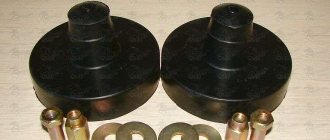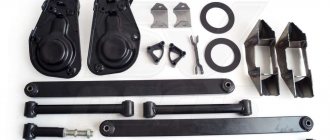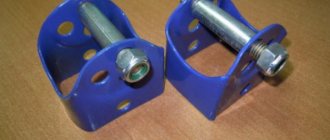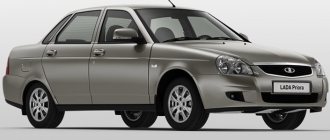Ground clearance is the distance from the surface of the earth to the lowest point of the car. It’s no secret that the higher the ground clearance, which is also the ground clearance, the more passable the car. So what is the ground clearance of the Lada Largus? According to official data, the ground clearance of the Lada Largus is 145 mm. Is it a lot or a little? We'll talk about this further.
Steering wheel, panel and door cards
The first thing that catches the driver's eye is the new steering wheel. To be precise, it’s not completely new, but exactly the same one could already be found on XRay and Vesta.
But it is worth noting that the steering wheel looks much nicer than the old one, feels good in the hands and, of course, its separate plus is the presence of additional control buttons, which will please many drivers.
The devices are combined in XRay and Vesta style and are represented by three wells, the rims of which are made to look like chrome.
As many people know, most Renault cars for the Russian market are assembled at AvtoVAZ facilities, which is the reason for the great similarity between some VAZ and Renault models.
By the way, the new Largus received updated headlights, which are very reminiscent of the Renault Logan headlights. The dashboard and door cards of the updated version are no exception and are taken from Renault Duster. The panel is made almost identical to the one used in Duster before its latest update.
And the door trim of the new Largus is so similar to the trim from Duster that it suggests that these are most likely the same cards. The glass control unit has also changed, and it is also taken from Duster.
I decided to compare Largus with the vans that I had and what came of it...
Hi all! Sorry that I’m writing again in the bortovik, it seems like there is such a topic for comparison. It’s just that my test turned out to be extensive, and the on-board test is somehow more convenient for me. Please don't kick too hard
In general, again, at the request of radio viewers and television listeners, I decided to compare the cars that I already had (28 in total) with Largus. Only cars in a similar price category will be subject to comparison, i.e. those that can be taken as an alternative to Largus, but used. and only those that he touched himself. So let's get started, the MMC Chariot Grandis (N84W body), MMC Grandis (narrow-eyed), Ford Galaxy (II) and S-Max have received approvals for comparison. I will briefly discuss a few others separately. MMC Chariot Grandis (aka Space Wagon, left-hand drive, in the same body). I had a device, produced in 2002, almost at maximum speed, white mother-of-pearl color. Imported to order from Japan from auction.
On the plus side , there are a lot of bells and whistles in the factory configuration: two air conditioners (the second for the second and third rows), a rear camera and parking sensors all around, everything electric (mirrors, glass), climate control, standard xenon with a corrector, and whatnot. then, I don’t remember anymore. Quite spacious interior, normal appearance (many Japanese come from the factory with a body kit). Fuel consumption on highway 8, in the city 12-13 liters. The third row, although similar to the Largusovsky in the luxury (in essence), can be moved along the trunk, thus either reducing the trunk and increasing legroom for passengers, or vice versa. All seats have backrest adjustment, even in the third row.
The most important thing is the disadvantages: 1. The second row of seats is cut in half, in a proportion of 50x50. Which is terribly inconvenient for all of us. When someone wants to tilt or raise the backrest, the person sitting in the middle has to hang in the air with one side of the body... To be fair, each of the halves can move back and forth around the cabin. In my opinion, the left-hand drive version has a solid seat. 2. GDI engine - at one time it was presented as a super new and mega-technological unit. Type to save fuel and improve driving performance. In fact, his 161 mares are probably also from Japan, or from somewhere in Asia, very small and unwilling to travel, yet designed for 98 gasoline and guzzling it with pleasure. In addition, GDI (Gasoline Direct Injection - direct fuel injection) implies the presence of a fuel injection pump - which is very critical to the quality of the fuel. In GDI, the engine runs on a very lean mixture, which leads to relatively frequent coking of the engine, and you have to periodically clean it (at a service station, which is not cheap), or regularly go to the highway once a week and give the country coal... (I have no problems with this was) 3. The cost of spare parts at that time was not exactly cheap. And now, probably, too, I haven’t watched it, to be honest. 4. Delicate automatic transmission (applies to right-handed options). 5. There is a little more space in the cabin than in Largus - in the front and on the second row, in the third - in Largus there will be even more. Plus, Largus has windows. The summary is this - if you don’t take into account the location of the steering wheel, then look at the Space Wagon (left-hand drive) with a 2L engine (the good old 4G63) and a manual. The most hassle-free option. For this price (350-400 thousand), until recently it was possible to take a Largus norm of 5 seats. Now I don’t know anymore. Considering that its production stopped in 2004, the chance to take a live device is equal to the chance to buy a new Largus at the cost of a 2012 MMC Grandis (snake-eyed)
I liked this car a lot, and I still like it too. But, again, there are no cars without nuances. The background to his purchase is this: for the money, he was a very good value for me. In terms of price/year/quality/bells and whistles – too. The base mass of the Grandis is 7 places. Having looked, we realized that in the second row there was no room at all for legs, even less than in Largus (my wife couldn’t even sit behind me, or rather she could, but the lumbar support worked for me). And we switched to other cars (Toyota Sienna, Dodge\Chrysler Caravan\Voyager). There was nothing interesting there in terms of its condition, and once again returning to Mitsu I decided to look at the 6-seater version. And here, oddly enough, there was very little legroom (though who knew that Nikitos would explode upward during the time he owned this device). But the 6-seater also has disadvantages, which are discussed below. After realizing that 6 seats was suitable for us, a device was found and purchased in very decent condition, at almost maximum speed and at a normal price. So, the advantages: 1. A regular 16 valve engine, which is the funny thing, with the same consumption as the GDI in the city - 12-13 liters, but on the highway more - 10 liters, versus 8 for the GDI. 2. Comfortable, soft suspension. Driving is a pleasure. Good cross-country ability (well, not a jeep, of course, but I climbed in such places that it was scary). 3. Good transformation of the interior, especially the trunk (3rd row of seats). Each of the two seats in the 3rd row can be removed into the floor, in its place a recess is formed where you can stuff a lot of things. If you fold the third row, you get a flat floor. The second row can be moved close to the front ones. In general, the transformation of the third row (and the interior in general) at Grandis is in second place for me after the Galaxy\S-Max.
4. My configuration includes two hatches (although this is also a minus, see below).
5. High-quality leather/possibility (with heated front seats), climate control, everything is electric, etc. 6. Two stoves\two air conditioners (the second for the second row and gallery) Cons: 1. The main one, in fact, is why it was sold - the presence of two hatches if there are more than two people in the family taller than 180. The hatches eat up three centimeters above the head, if not more. Actually, I described this in a note about a trip to Bulgaria. It turns out that in the 6-seat configuration there is more legroom and less headroom. The actual cost of spare parts remained at the “level” of Mitsubishi, so to speak.. True, there are a lot of substitutes. In terms of prices, it turned out to be even slightly cheaper than the first Grandis. 3. The suspension is said to be delicate in terms of maintainability. I don't know, I didn't notice. The only thing is that almost before the sale I changed the rods, they were worn out like trash. That's all. But their cost... see point 2 4. There are no radios to replace them in a regular place. It is not quite a standard form and the bookmaker is tied to it. Even the Chinese have problems (this model was also produced in China for the domestic market). 5. Driver's wiper - 71 cm. Not available in all stores. In general, if you are up to 175 cm tall, the Grandis will be a good device, I looked at the specialist; at the beginning of March, for the money of the new Largus in the deluxe, you can get a relatively lively Grandis, 2006-2008. If it weren’t for Nikitos, maybe I would have ridden it like that. Next after Grandis I had a Ford Galaxy II . The model has been produced since 2006, in 2010 there seemed to be a slight restyling, it is still sold new, but the price tag - from 1,300,000 seems to be... nutty. To be honest, it’s not entirely correct to compare Largus and Galaxy, or rather it’s not at all correct, the cars are completely different classes. It's like ZAZ and Chaika in Soviet times. Now the details.
I had a Galaxy diesel, 2 liters. Dieseluk Pezhoshnaya, 141 hp. , 340 (!!!) Nm... 340!!!! The power and stupidity of this engine killed me on the spot every time I just drove. If you’re traveling alone or if you’re jam-packed, you don’t really want to – it feels like it’s purple. The same confident acceleration (you really need to brake more carefully), practically the same fuel consumption (city 8, highway - my record is 5.4, average 5.7-6.3, and this is with an empty weight of 1750 kg, if I remember correctly memory). In general, not a car, but an airplane. But these are emotions. Now let's move on to the facts in the form of pros and cons. And here I will first describe the disadvantages, and only then the pros. So the minuses: 1. The first minus is precisely its plus. This is actually the diesel itself. Here is the CommonRail system. This is many times better than the earlier pump injector system installed on the Galaxy I and also the VW Sharan. But, nevertheless, it is good until it breaks; repairing the system (not the engine, this one is practically “eternal”) can cost a very substantial amount. The experience I had on the last S-Max before Largus showed that you can easily go for 60 thousand rubles simply by cleaning the system and carrying out a preventive overhaul of the fuel injection pump. 2. In continuation of point 1, I want to say that since the engine is turbocharged, the requirements for oils, and especially fuel filters, are increased. The filter is only original. I also encountered a non-original one. As a result, it may cost you more (see the end of point 1) Maintenance interval – 10,000 km. 3. On diesel engines with manual transmission, the dual-mass clutch flywheel is a huge minus. Which often leads (Ford, you see, took care of consumers to make it comfortable to start, while complicating the design). This problem can arise after 100 thousand kilometers in a metropolis. Replacing a clutch kit (if you're going in there, it's better to change everything at once so you don't have to climb twice) consisting of: flywheel, basket, clutch disc, hydraulic release, and also all sorts of oil seals along the way, comes out to an amount of more than 45 thousand rubles at pre-crisis prices prices. The flywheel alone cost 25 thousand. It’s easier to shoot yourself (Although I later learned that not only Ford began to dabble in dual-mass flywheels... and not only on diesel engines) 4. Complete absence of a spare wheel as such, complete!!! The repair kit consists of a pump and a can of sealant; take it to a tire shop. There’s not even a provision for additional equipment (they say that after 12 years they seem to have returned the additional equipment for the Russian Federation, I don’t know, I haven’t checked). That's why people buy spare parts from the Volvo S80 and carry it with them, some in the trunk, some on the side of the roof, some hiding behind the second row seats. There are many threads on this topic on the forums. 4. I didn’t find any more minuses, look at the rest in the pros. Pros: 1. Well, actually, the very first minus is the very first and bold plus. I described this in the preface to the model. Both consumption and high-torque. Everything is great. 2. The interior is transformable, as it is fashionably described in outbid advertisements - a complete transformer. All 7 seats are adjustable and tilt separately from each other. The last two rows fold into a flat floor. Absolutely flat, from the tailgate to the first row. And it's great!
3. Third row, two separate seats that can move back and forth and have an adjustable backrest. The vents are the same as on Largus 4. Under the feet of the second row there are niches in the floor where you can put a bunch of different junk. Plus the same niche in the trunk behind the seats. 5. Half of the trim levels have an overhead console that extends (I can’t find another word for it) from the trunk to the windshield. It has four opening drawers, an eyeglass case and two or three interior lights. I don't remember anymore.
6. A bunch of cup holders, containers, etc. 7. Heated windshield in the base. Moreover, if the temperature outside drops below zero, when you start the car, the heating turns on automatically. And on the windshield, and on the rear, and on the mirrors. 8. Dual-zone climate control in the base (with the exception of vegetable trim levels with a 1.8 diesel engine, there is just an air conditioner). Moreover, air is supplied to the second row both from below into the legs and on the side in the central pillars there are air ducts. Super.
9. All trim levels have radio controls on the steering wheel. 10. Half of the base models have heated front seats, some also have ventilation. The main engines on the Galaxy: - 2.0 petrol, chain, manual only. It drives fine. In the city he eats an average of 11-13 liters. — 2.3 gasoline — automatic transmission (6-speed, Japanese Aisin, adaptive). Convenient - yes, eats around the city 12-14. It often kicks when shifting 1-2, the automatic transmission is very compact, does not cool very well, the channels are tiny, due to the operating algorithm, the clutches quickly wear out and wear products clog the channels. Officially, the oil does not change throughout its service life (ha ha ha). But if you initially change the oil in it every 60 thousand, it will last happily ever after. — 1.8 diesel. I won’t say for sure, but in my opinion this engine is not CommonRail. There are people on the forums who drive them, but, as a rule, the configurations on them are poorer, and in terms of repairs, this engine will be more expensive (namely repairs, not routine maintenance). Happens only on mechanics. According to the owners, it goes, but of course it doesn’t reach the two-room mark. (PS. clarification dated April 20 - it seems to be a CR engine, but it differs in the power supply system (it seems like Delphi and Bosch were installed on Ford diesel engines, on 2.0 Delphi), and one more thing, it turns out there are configurations with 1.8 and not completely poor , even with the climate, but there seem to be no maximum temperatures with it.). — And finally, 2.0 diesel. The pros and cons are described above. It happens with both automatic and manual transmissions. I had both options. On the mechanics it drives super. Feelings at the beginning of the description. With automatic transmission – it costs the same Aisin as on 2.3. The algorithm is just different. But... In the city it eats around 11. Which really upset me. Maybe when the engine is new, it runs around 9-10. But for the price of the new Largus, the devices have already been used and there will be no such expense. My summary: The Galaxy device is amazing. In my rating, the car (out of the 29 that I had) is in first place. But I was very, very lucky with my copy. Thank God that I was able to take it then. The new owner has already won half a mile on it in two years and is happy as an elephant. And my master, before purchasing, told me that a better device could not be found, even more expensive. What is now being sold for the money of a new Largus is mostly already worn-out devices. Of course, sometimes something worthwhile for reasonable money flashes by, but it goes away in an instant. And often, unfortunately, to outbid. And if you are suddenly offered a Galaxy of the Year 2008 with a mileage of up to 150 thousand km (real) and with one owner - take it without hesitation. This machine will not disappoint you. But they are one in a million. That's why you are here, on this forum, and not on the S-Max\Galaxy forum. After the Galaxy, I had two S-Maxes – 2.3 petrol and 2.0 diesel, both with automatic transmission.
The differences between the S-Max and the Galaxy start from the second row. The Galaxy has a straight roof, while the Max has a flat roof. Due to this, it looks more interesting, sportier or something. There is exactly the same amount of space in the cabin as in the Galaxy, except for the gallery. The third row in the Max is frankly flawed. Even my Danka had little space there, and in order for him to sit normally, I had to move the second row seat closer to the first.
But people on the forums install seats from the Galaxy and enjoy it, because the legroom becomes like in the Galaxy. This does not interfere with folding. Below is a comparison of the Max and Galaxy seats installed in the Max.
To be honest, I would only take the five-seater S-Max. Awesome trunk and excellent comfort for five passengers. There are also configurations with a retractable trunk floor, a very convenient feature.
I would also like to briefly dwell on the following machines (I won’t focus on right-handed ones, there is so much of everything that there is not enough time or effort to describe them...) that I managed to touch. 1. Kia Carnival - there is both diesel and gasoline. Both automatic transmission and manual. Having caught fire, I touched it, but was not impressed. No way. Some people like them, but I don’t really like them anymore. Transformation of the interior at the VW Sharan level. Consumption is clearly more. And reliability, they say, is not very good.
2. Chrysler Grand Voyajer \ Dodge Grand Caravan - I don’t know about anyone, but for me they no longer exist. Maybe the cars are not bad, but: they eat a lot, it’s uncomfortable to sit, the quality of the plastic is at the level of a VAZ 2106. Not impressed. I didn’t even consider cars without the Grand prefix anymore.
3. Toyota Sienna - for the money of Largus you can only buy either the first generation (until 2003), or the 2003, 2004 second generation. With mileage far beyond... Very comfortable, pretty (second generation), everything you need is there. But...: it eats a lot, the mileage is crazy, the interiors are shabby. If Sienna, then closer to 2010, but that’s another story, and money...
4. Hyundai Grand Starex (which is N-1) . Large, spacious interior, quite comfortable. Diesel engine, 90% of cars with automatic transmission. But there are no survivors for Largus money, mostly cargo ones. Yes, and there is a problem with diesel engines brought from Korea, with some not very high mileage, either the liners turn, or some other similar problem, and the engines need replacement, or expensive repairs. For some reason, I’m not at all surprised by this, because when I had a Hyundai NF, I was specifically looking for one with a two-liter engine, since it has a chain engine. It turned out that according to Hyundai regulations, the chain is changed after a mileage of 120 thousand km, and the cost of replacement, in the club service with discounts, was around 40 thousand. For right-handers, with a mileage of 250, only the tensioner was changed. Just like that.
5. VW Sharan – I looked, but not for long. I don’t like it purely externally and internally. Although it also has its advantages.
6. I almost forgot Mazda MPV
I wanted to, looked/touched. I didn’t like it, although a guy at my work took it and was happy with it. What I liked is that there are two seats in the second row, but the right one moves to the side if you need to go to the gallery. That's all. For me. Of the minuses - it eats a lot, the third row is completely uncomfortable, the interior is simple. Did not impress. 7. I almost forgot 2 Citroen C4 Grand Picasso
I also looked closely for a long time, I wanted to, but: 1. On 1.6 diesel engines there is a robot that needs permanent adjustment. Hydraulics are only available for the 2.0 diesel (the combination is almost the same as for the Galaxy), which is practically not delivered to us due to the prohibitive prices for customs clearance. I didn't even consider gasoline. 2.
Despite these normal dimensions, there was very little room in it for my family: I rest my head on the visor (the visors are tricky, they can be moved up and more glass space above the head is added, but personally the visor rests almost immediately on my forehead). Nikitos in the first row could not attach his long limbs; in the second row he was not much better. Danka, as a gallery lover, was completely stuck in the third row. My legs were stuck under the second row of seats. 3. A lot of whims on the part of electronics. And for a reasonable price there are a lot of different cute things, and it’s relatively cute. Here is a brief description/comparison of the machines. If someone finds it useful, I will be glad. And another short summary: I sometimes look at advertisements for the sale of minivans, sometimes even right-handed ones. Sometimes you come across examples that are not bad, but... When you start to analyze that the car is used, you don’t know who used it and how it was used before you, where and how it drove and what troubles it was in. And if God forbid it breaks, how much could all this cost. And every time I praise myself for taking Largus. Yes, it is not without its shortcomings, but... it is new, under warranty, spacious, and most importantly, it performs its functions 100%. Here recently on the Ford Drivers forum they asked me: “Well, how is Largus after Ford?” I answered everything honestly, and then my old master, described in this article, inserted his 5 kopecks (Quote) “ such a cart came to us (he calls all the cars, except for the old-school Americans, rem. banich), and I took a closer look at it (I already had a lot of positive feedback from my respected friends). I confirm: a rare example of a car worth every penny of its price, and generally made solely in the concept of practicality. Yes, this is, of course, a Spartan device, but if, for example, you take the new Focus Ambient 1.6 with a handle - and people buy them! - and Largus, then the cost of the “social marketing” component of the modern automobile industry becomes obvious. Because the focus is not better than ANYTHING (but much worse), it just costs differently...” (c) So let’s draw conclusions, gentlemen... Rough roads to everyone and fewer abbreviations on them
Seats
The front seats now have a slightly reshaped shape. We can definitely say that the new shape of the front row seats is a little more comfortable, which will be a small advantage for those who plan to spend a lot of time in the new Largus, but the back will still get tired, but in the top modifications the situation is a little better.
In rich trim levels, the front seats have acquired side supports, and their plastic part has acquired a partially glossy color. And finally, AvtoVAZ has positioned the seat adjustment elements relatively conveniently.
The rear seat can also be different and depends on the configuration. The cheap versions have a far from comfortable solid seat with a solid backrest. But more expensive versions of Largus can boast a divided rear seat, which has special niches for plastic seat belt buckles and even a heating option.
Starting with the Comfort version, the manufacturer offers the use of a third row of rear seats, which folds towards the back of the rear seats.
By the way, if necessary, you can simply remove it from the car and increase the size of the trunk.
How to increase ground clearance on Lada Largus?
There are several ways to increase the ground clearance of the Lada Largus. The main ways are:
1. Installation of larger diameter wheels and higher tires. 2. Installation of special spacers. 3. Installation of larger shock absorbers and springs.
The first method is one of the simplest, but at the same time the most expensive in terms of finances. But this method also has a significant drawback - a small percentage increase in ground clearance. For example, from the factory the standard tire size for Lada Largus is 185/65 R15. We can increase the height of the rubber, for example, by 5 units. Those. take tires 195/70 R15. In the first case, our tire height was 120 mm, and in the second - 136 mm. In fact, we will increase our ground clearance by about 16 mm. Immediately such an increase in height is quite good, but there is one caveat - tires with a larger diameter and height can touch body parts or wheel arches when turning. The speedometer may also not work correctly, since it is calibrated from the factory for a certain wheel size. And a wheel with a larger diameter will make fewer revolutions, and accordingly the speedometer will start to lie.
The second method is also not complicated, and the money won’t be very expensive. You just buy spacers for the shock absorbers at the store and install them.
Spacers are sold in different sizes. The design turns out to be quite reliable and safe. However, if you have to re-register such a car with the traffic police, it is unlikely to succeed - inspectors will be sent to fix the installation of spacers. By law, such a modification is a change in the design of the vehicle.
The third method is the most competent from a technical point of view. Its essence lies in the selection of increased springs and extended shock absorbers for the car. In terms of cost, it is approximately equal to replacing tires, since good struts and springs cannot be cheap.
Multimedia system
And here we are again reminded of the previous version of Duster. The multimedia was installed from him. However, it is worth noting that it did receive a number of changes. The system now works with both CarPlay and Android Auto.
It is very difficult to call the work of the entire system good; rather, it is simply normal. It slows down, sometimes even a lot, but still works without critical failures. The same can be said about the speakers, they play and play, but special music connoisseurs will still want to change them soon. A rear view camera has also appeared.
Main disadvantages
Naturally, it’s difficult to talk about the shortcomings objectively, since everyone has different requirements, but it’s worth highlighting the main points that users don’t like the most:
- good sound insulation only in expensive versions;
- The seat heating control unit is inconveniently located;
- it is inconvenient to control the climate system;
- not very convenient control of the multimedia system;
- no front handles on the ceiling;
- The heating of the windshield does not cover the edges (the wipers do not cover them either).
Changes in the interior of Largus 2022
Upon careful study of the new model, you will notice that there were no revolutionary changes in the design. The use of higher-quality modern materials in the decoration of seats, doors and ceilings allowed us to transform the interior. Many parts have a special glossy anti-scratch coating; in combination with the chrome decor, the interior looks more expensive and comfortable.
A more comfortable atmosphere is created by new materials with increased noise insulation, which were not present in previous models. The updated Largus is equipped with very convenient accessories for storing personal belongings, which was approved and appreciated by car enthusiasts. Owners of the new model will also be pleased with the anatomically shaped seat, which holds the driver’s body well when turning.











